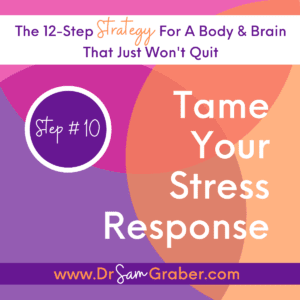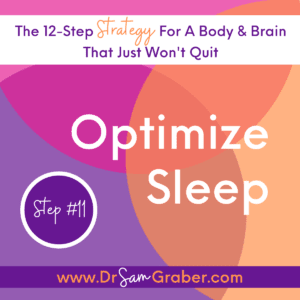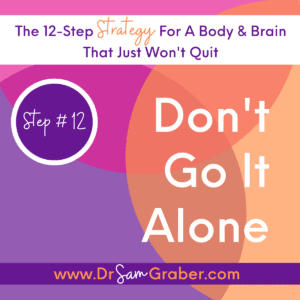
Why You Can’t Sleep In Perimenopause And What To Do About It.
Have you ever tossed and turned all night?
If it’s a once-in-awhile thing, it’s not all that big a deal. But when one night turns to two. Then three and four, it can set off all the body’s alarms. In turn sending your entire system into panic mode.
As if perimenopause wasn’t challenging enough, when insomnia joins the symptoms ranks, it can send us over the proverbial edge!
A Systems-Wide Panic
When in a systems-wide panic, your body becomes a hoarder. This stress swiftly shifts the hormonal stream to “All Things Cortisol” seeing that cortisol is your main stress hormone.
And boy-oh-boy is she demanding.
The first item on her agenda is to bark orders at your cells that they are to shunt all available energy into storage. Cortisol’s job is to ensure we have enough energy on hand to make it through any given catastrophe. And as far as she knows, when she’s on site, we are in crisis.
We store all that energy in our long-term storage-locker, body fat. Insulin gets the nod to do that dirty deed.
“No Cholesterol For You”
Cortisol is built upon the same cholesterol backbone as are many of our other important hormones. A few of those are progesterone, testosterone, and each of our 3 estrogens.
When we’re in perimenopause, we’re already behind the estrogenic 8-ball. Add to this natural decline the fact the body will shunt cholesterol towards cortisol when under stress, and therefore away from our sex hormones, the effects of stress are felt all over.
Did you know that many human cells have estrogen receptors?
These estrogen receptors are located in the female reproductive tract and breasts as one would obviously expect. But possibly less obvious, there are ample receptors in our bones, liver, colon, skin, our salivary glands, and our brain. That last one is a biggie when it comes to sleep.
Our cells love them some estrogen. And as we enter perimenopause, estrogen plays harder to get. Which can lead to all sorts of issues.
To add fuel to that dumpster fire, there are tons of chemicals vying for these receptors as well. Most notably the xenoestrogens.
Xenoestrogens are not natural. They are industrially made.
Ample evidence suggests that xenoestrogens are harmful to human health. We are exposed to them through our food and drink, our personal care products, and our environment. (This little gem of a topic is deserving of its own blog post. And she’ll get it, in time.)
When stress is on scene, especially chronic stress, cortisol gets all the focus. As she should.
Survival Trumps Sex, And Sleep
The alarm has been pulled and since cortisol is the hormone that helps us stay alive, it gets all the cholesterol assets shunted in its direction.
Your body is pretty smart that way; staying alive trumps all other activities. Sleep included.
Cortisol sticks around for a good while even when the “threat” has passed. As such, the more stress (chemical, physical, emotional) you are exposed to before trying to drift off to sleep, the less able you are to fall asleep, and stay that way.
Now unfortunately cortisol renders insulin inept. It does this because from a survival point-of-view, the body wants glucose immediately available just in case we need to outrun a tiger.
As a result, the constant state of stress wreaks havoc on your metabolism. Every time your body gets a rush of cortisol, it also gets a hit of glucose to fuel the potential need for running from danger. And then a bolus of insulin is released to clean up the biochemical fallout.
When we have a constant release of glucose, we need insulin to tell that glucose where to go.
- Will we use it for immediate fuel?
- Or store it away for future use?
And as I just noted, when cortisol is on duty, she tells the lioness’ share of your cells to store that energy for later. We do that in our body fat.
The body doesn’t distinguish what type of stress it is under. To the body, stress is stress!
This is how you can be absolutely exhausted yet be unable to sleep.
As if this wasn’t enough, the number on the scale creeps up despite “how little you eat and how much you exercise”. Your waistline expands beyond your typical monthly ebb and flow.
It’s a whole battle-of-the-wills type deal and you, along with your zzzzz’s lose. Your melatonin is affected and your circadian rhythm gets jacked up, which delivers the final knockout to your ability to sleep.
Everything Changes In Perimenopause
You’ll often hear me say, “the better you understand your body the better you can care for it.” It is a life philosophy of sorts. Add to this philosophy my strong faith in the body’s inborn intelligence, and you’ve got a solid idea of how I approach this thing called perimenopause.
If you slept soundly prior to reaching this stage in life, all bets are off. If you rode the insomnia rollercoaster on the regular, that ride may get even steeper during this time. Sorry to say.
If you toss and turn on the regular or more often than once-in-awhile, incorporate steps 10 and 11 from my 12-Step Strategy For A Body & Brain That Just Won’t Quit ASAP! Your perimenopausal body and brain will thank you.

Step # 10: Tame Your Stress Response
Stress runs our lives, for the most part.
Stress isn’t just unpleasant, it is deadly. It wreaks havoc on our biochemistry.
Stress releases cortisol. What was once a “running from something trying to eat you” event has now turned into an “all day, day after day” event.
Cortisol inactivates insulin. Despite the fact that the body is literally marinating in the stuff (insulin), it is unable to put it to good use where it needs to be of good use.
Where is that?
Shuttling the excess glucose from carbohydrate consumption and the hits we get from all the chronic stress as previously noted. It must lock all that excess up, and right quick, so the glucose isn’t turned into a bowling ball with spikes on it (a glycated Red Blood Cell).
Glycation is what gets measured when your Hemoglobin A1c is tested.
Here’s the scene… the pancreas sees a bunch of excess glucose in the blood. I’m sure it says something like this, “didn’t I just clean up this mess? I tell ya! A pancreas’ job is never done.”
So back to work it goes. Pumping out insulin.
It sends off another massive bolus of insulin which is again rendered inactive by still more cortisol.
This is one vicious cycle.
It is a biochemical battlefield. One which you and your zzzz’s lose every time.
You can tame (some of) your stress by incorporating a mindfulness practice.
Mindfulness is an ancient practice for becoming aware of our thoughts and being still. Being still is incredibly difficult for people like me who move 90 to nothing all day long. I’m just wired that way.
Until I really embraced a mindfulness practice, I never felt at peace. Step # 10 has been a life changer and has helped me focus on the big things and stop sweating the small.
Any length of time spent in the pursuit of mindfulness is time well spent.
I made a 15 minute Full Spectrum Energy Center Opening Exercise video that you can listen to on the “Dr. Sam Graber” YouTube channel. You’ll find that at https://youtu.be/6LGnYZbyaFQ .
Listen every night to feel your stress level lessen after each 15 minute session. In fact, do a little experiment to see how well it works for you.
- Rate your stress level before hitting play, 1 = No Stress to 10 = Stress Overload
- Listen to the 15 Minute Full Spectrum Energy Center Opening Exercise
- Rate your stress again, 1 – 10, after listening. How much did your level decrease? Mine usually decreases by two to three points after my evening session.

Step # 11: Optimize Sleep
Did you know that sleep has a profound effect on your weight set point? In fact, inadequate sleep quantity AND quality can sabotage your fat loss efforts despite doing everything else “right”. It is that important.
The sleeping pill-induced kind of snooze doesn’t make the cut. Sleep isn’t just a passive thing. So knocking you out (so to speak) does not get the job done.
There is a ton of biochemistry going on behind closed eyelids. It’s a critical daily need for being truly well: mentally, physically and emotionally.
You must prioritize your sleep. Every aspect of your wellbeing depends on it.
My top 7 tips for stacking the sleep deck in your favor:
- Set a sleep schedule and follow it every day.
- Develop a soothing bedtime ritual. A minimum of 30 minutes in length.
- Remove all digital screens from the bedroom.
- Increase exposure to daylight while minimizing artificial light.
- During the 6 hours prior to bed, avoid caffeine and during the 4 hours prior, avoid alcohol.
- Do not nap if you’re having difficulty sleeping. If you sleep just fine, a nap may be okay for you.
- Exercise every day. At a minimum, move your body every day.

Step # 12: Don’t “Go It Alone”
As mentioned earlier in our series, the default setting for the human is procrastination. That said, it’s imperative to embody Step # 1 (Take Immediate Action).
Ensuring it is the correct action is critical. Not too little and not too much.
Having a skilled advisor in the mix is a way to compress the learning curve, stave off quitting, and to break through mental barriers you didn’t even know were keeping you back.
This is where # 12 shines: “Don’t go it alone!”
I’m as independent as they come. It is a core value. I teach clients how to be independent as well.
I want you to be independent of the hype. From taking conventional wisdom at surface value. Independent from fake food. From drugs. From limiting beliefs.
From e’rything that does NOT serve you well.
Everywhere you turn, you will be faced with some sort of marketing trying to influence you to buy into a life of dependence marketed as “convenience”. Every. Where. You. Go.
You have to build up an immunity. You do this through education and flexing your habit muscle. I offer my clients a means for opting-out of the future so many Americans are destined to have.
Heart-To-Heart Time
How many times have you attempted to make a lifestyle change, but then you got off track and quit? A couple, 5, 10…? If you’re like most people I’ve met, it is too many to count.
You know things need to change, but it’s so darn difficult!
Much of that difficulty comes from our mindsets, or the way we think about something. In this case, it’s the mindset that the answer to what ails us is found in some pill or product or program; in other words, something outside of us.
That mindset is unhelpful, not to mention unnecessary.
I’m going to save you ridiculous amounts of money with this nugget right here: the answer lies within you. 100% of the time.
You don’t need some overpriced product, nor some fancy piece of exercise equipment to “finally succeed.”
Every single thing you need lies within. You just need to tap into it with your personalized strategy.
From Midlife Crisis To Midlife Unraveling…
Most folks find their way to me after years of struggle with their weight, their overall health, their lack of direction in life or some variation of all three.
It’s so very common, especially in our perimenopausal phase of life.
Questioning what life is all about is very natural at this point. But in the same breath, the biochemical fallout has had time to accumulate and has changed the playing field. For good.
Further stacking the deck against you.
Unless and until we correct those problems, all the “diets” in the world will not produce lasting results.
You cannot get where you want to go if you don’t know where you are currently. When left to our own devices, we procrastinate. It’s just a human thing.
Where Do You Go From Here?
First and foremost, decide it is time for you to take care of yourself.
Remember my story? I know where you are mentally and physically. I’ve been there. I specialize in helping people who are frustrated with their current status. You see, they’re like I once was, trying to do the right thing but they’re continually caught in this revolving door of failure.
That is what my private clients were experiencing as well, and why they were willing to step out of the “expert consensus box” as I did. They also understood that to continue to go it alone was to set themselves up for yet another failure.
After working with hundreds of clients in a one-to-one setting I maxed out my time and therefore my ability to help those who needed it most.
In order to impact more people than I was able to by working in a private client setting, I created an online ecosystem. This is where people can access free information and join a paid CoWorking group to access coaching at a group rate.
In homage to Brené Brown, I named the community “Unraveling Together”.
Unraveling the mass of accumulated habits, beliefs, self-imposed restrictions and other things that hold us back in life, love and business is the foundation of the work we do in Unraveling Together. https://www.unravelingtogether.com/
Decision Time
Now that you have learned key strategies for a body and brain that fire on all cylinders, it is time to make a decision. Do you go it alone or do you join a community of other midlife women who are rolling up their sleeves and doing the work?
